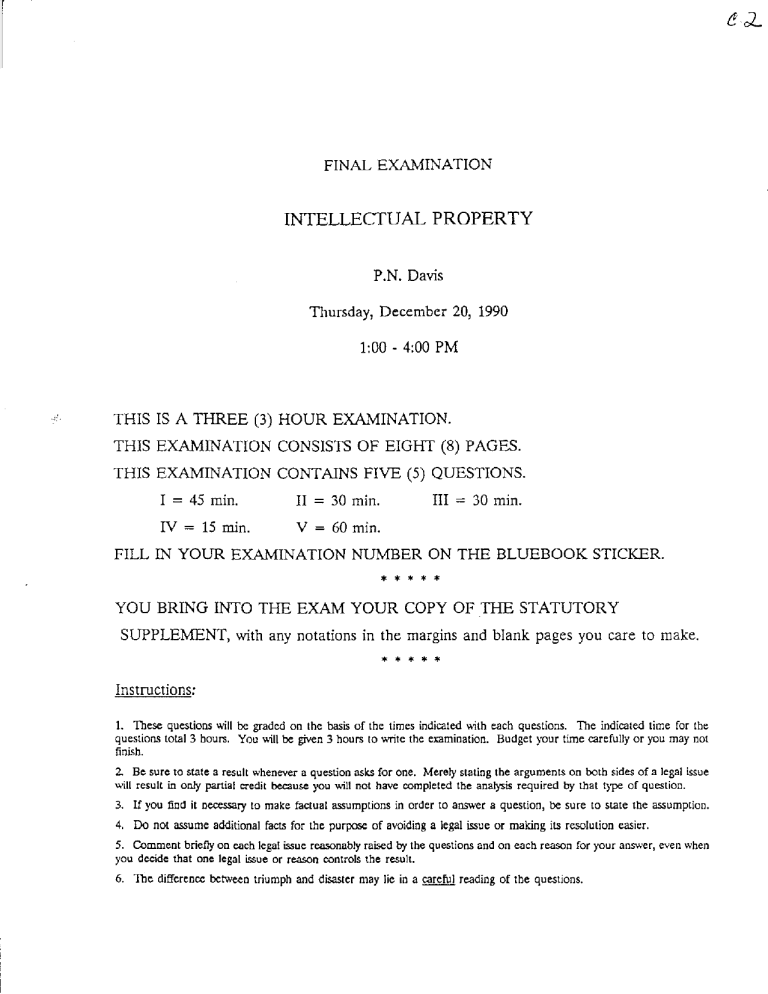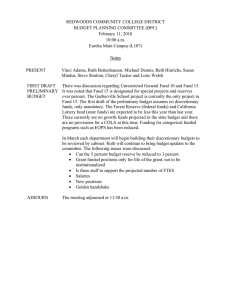INTELLECTUAL PROPERTY

FINAL EXAMINATION
INTELLECTUAL PROPERTY
P.N. Davis
Thursday, December 20, 1990
1:00 - 4:00 PM
THIS IS A THREE (3) HOUR EXAMINATION.
THIS EXAMINATION CONSISTS OF EIGHT (8) PAGES.
THIS EXAMINATION CONTAINS FIVE (5) QUESTIONS.
1= 45 min.
IV = 15 min.
II = 30 min.
V = 60 min.
III = 30 min.
FILL IN YOUR EXAMINATION NUMBER ON THE BLUEBOOK STICKER.
* * * * *
YOU BRING INTO THE EXAM YOUR COPY OF THE STATUTORY
SUPPLEMENT, with any notations in the margins and blank pages you care to make.
* * * * *
Instructions:
J. These questions will be graded on the basis of the times indicated "ith each questions. The indicated time for the questions total 3 hours. You will be given 3 hours to write the examination. Budget )'our time carefull)' or you may not finish.
2.
Be sure to state a result whenever a question asks for onc. Merely stating the arguments on both sides of a legal issue witl result in only partial credit because you wilt not have completed the analysis required by that type of question.
3.
If you find it Decessary to mal(e factual assumptions in order to answer a question, be sure to state the assumption.
4.
Do not assume additional facts for the purpose of avoiding a legal issue or making its resolution easier.
5. Comment briefly on each legal issue reasonably raised by the questions and on each reason for your answer, even when you decide that one legal issue or reason controls the result.
6. The difference between triumph and disaster may lie in a careful reading of the questions.
r.
(45 minutes)
Babe Ruth hardly needs an introduction; he was one of the greatest baseball players of all time, both as a pitcher and home-run hitter. While he lived, Ruth was paid by manufacturers for the use of his picture or name in promoting the sale of various products.
Ruth registered the words "Babe Ruth" as a trademark for "paper articles, playing cards, writing paper, and envelopes". He licensed Babe Ruth League, Inc., to use the trademark to promote its amateur baseball league and to sell products bearing the
"Babe Ruth" name. He retained the right to license the mark to third parties.
Recently, Devine Publications published the Great Baseball Players Engagement
Calendar. The Devine logo appeared on the front cover, title page, copyright notice page and back cover. The words "Babe Ruth" do not appear in any of those locations. There are 52 pairs of pages in the calendar. Each right-hand page consists of the calendar for a given week, with room for the purchasers to make notes of appointments, supplemented along the margin by baseball trivia related to the particular dates.
Each left-hand page bears a photograph of a baseball player, ballfield, or other item of interest to baseball fans.
For example, the week of June 13 features a photograph of Lou Gehrig crossing home plate, while the week of October 17 displays Mickey Mantle in full swing.
Three photographs of Babe Ruth appear in the calendar, one with Ruth helping a small boy with his batting grip on the front cover, one of Ruth saluting General ohn
Pershing for the week of October 31, and one of a baseball autographed by Babe Ruth for the week of December 5.
Ruth did not have a copyright in the General Pershing photograph, which had been obtained from the files of the Associated Press Sports
Department and published with its permission.
The other two photographs were reproduced from publicity photographs originally sold by Ruth at baseball memorabilia conventions. The Ruth/small boy photograph was marked in the margin
"Cl>
1979 Babe
Ruth". The baseball autograph photograph was not so marked.
1
A.
Assume that all these events and the taking of the photographs occurred during
Ruth's lifetime (i.e., Ruth died in 1990) and between 1978 and 1989, and that Ruth himself brought suit for damages.
Assume that the registration of the words "Babe Ruth" is more than 5 years old and is current. Does Ruth have any valid basis for recovery of damages?
Discuss all relevant legal issues. State a result.
B.
Assume that Ruth died in June 1990, that the autograph photograph was taken in late 1989, that the other two photographs were taken between 1978 and 1989, that the calendar was published in late 1990 for the 1991 year, and that Ruth's Estate brought suit for damages in November 1990. Assume that the registration of the words "Babe Ruth" is more than 5 years old and is current.
Does Ruth's Estate have any valid basis for damages? Discuss all new relevant legal issues. Do not repeat any issues discussed in part
A, except as a reference. State a result.
2
II.
(30 minutes)
Ozark Log Homes, Inc., builds handcrafted log homes usings oak logs from the
Missouri Ozark forests with a flat hand-hewn surface and connecting dovetail notches on the logs. The oak logs are taken from the core of the tree, measure 6 inches in depth, 12 inches in height and are up to forty feet in length. Their massive size requires a 15 ton crane to set the logs and thus the log houses cannot be sold as a do-it-yourself kit.
OLH decided to market their homes in July 1989 and filed for a trademark registration on December 10, 1989. It began marketing the homes in March 1990.
It began advertising the homes on a regular basis with the name OZARK Loo HOMES
In
January 1990 in various magazines, including Log Home Guide, Country Homes, TIle Log
Home Anllual, Mother Earth News, Alfenzative House Builder, and Better Building Ideas.
It established dealerships in Missouri and several eastern states during the first 6 months of
1990. Since March 1990, it has received about $ 250,000 in gross sales of its log houses.
Ozark Mountain Log Structures, Inc., began marketing a veriety of log structures, including commercial and residential buildings, in 1987.
OMLS uses round, pressuretreated pine logs not exceeding 15 in length. The logs are notched so that they can be erected by the home buyer into solid wood walls.
OMLS also manufactures hand-hewn square pine logs with dove-tailed ends.
It began advertising its structures in the same magazines in early 1987, under the name OZARK MOUNTAlN Loo STRUCTURES.
It has grossed about $ 1,000,000 in sales.
Its sales have been in Missouri and several western and northern states. OMLS filed for a federal trademark registration in July, 1989.
Both OLH's and OMLS's marks were published for opposition in February 1990.
Each filed an opposition to the other's mark.
The trademark examiner declared an interference in April 1990.
Is either OLH or OMLS entitled to a federal trademark registration on the Principal
Register? Discuss all relevant legal issues. State a result.
Can either mark be registered on the Supplemental Register?
3
III.
(30 minutes)
TV Guide is a very well-known nationally distributed periodical containing regional television schedules and articles relating to television entertainment. It is published in a format approximately 8 by 6 inches. The schedules are listed chronologically and contain short synopses of the programs. (For example, every program broadcast at 7:30 PM on a particular day is listed together.) Its listing are obtained from the listed TV and cable stations.
TV Guide has been published for over 30 years and is sold in grocery and magazine stores.
The Miami Herald newspaper in Florida decided to publish a television schedule booklet as a weekly supplement to its Sunday edition.
It is styled Miami Herald TV.
It, too, contains television schedules and articles related to TV entertainment. Its listings are obtained from the local TV and cable stations.
It was introduced to the newspaper's readers by an advertisement in every day's edition for the week preceding first publication.
(See copy of the advertisement, below.) The advertisement featured colored reproductions of the cover of the first issue of the Miami Herald TV and of an old issue of TV Guide.
Also, it compared the features and sizes of the two periodicals. Lastly, it mentioned that the new Miami Herald TV magazine was smaller than the old one, but larger than TV
Guide. After the Miami Herald introduced its TV schedule supplement, TV Guide's sales fell about 2 percent in the area of the newspapers circulation.
TV Guide brought suit for damages under the 1976 Copyright Act against the Miami
Herald for copyright infringement, for reproducing the cover of one of its issues, and under the Lanham Act for trademark disparagement.
Should the court grant the requested relief? Discuss all relevant legal issues.
4
ACTUAL SIZE.
The Herald's newTV Book.
It's a
little bitbigger and a little bit better.
~)'OJ open Jhe No.'t:":'\~ 20, edition 01 Ike Sunday
Herold, yov're going
10 open y¢'.Ir eyes to
0 very de·
~ ~t1le
SiJp-is.e
OUf
~. ~mOnef, more co-tverlienl
- ' SIU we bppec: oH q",;'e c le'Y'l'
~ oro...nC
he edges.
~ odded qV:le c bt te the midd\e. We now hove rl"O'e
1istngs.11'v'lo'e Thon TYGJide).
Emoier 10 reod !i5t·
The TV Book. At no extra cost in Sunday's Miami Herald.
5
IV.
(15 minutes)
Dietary Foods, Inc. owned the K+EFF mark for its brand of effervescent soluble dietary potassium supplement, which appears in the following logo:
The letter "K" is the chemical symbol for the potassium ion.
"EFF' is an abbreviation for "effervescent". The product is in the form of tablets and is dissolved in a glass of water by the user.
The effervescent action both speeds the dissolving process and causes turbulence in the glass of water as an aid to mixing. Dietary Foods obtained a registration for its mark in 1985.
In 1989 Electrolyte Supplements applied to register its K + mark for its brand of dietary potassium supplement, which appears in the following logo:
The examiner refused to register the mark.
Electrolyte appealed the rejection to the ITAB.
Should the ITAB affirm or reverse the rejection? Discuss all relevant legal issues.
V.
(60 minutes)
Standish.
In April 1986, Forrest Standish, an employee of Sludge Reduction
Systems, Inc. [SRS], conceived a sewage sludge reduction system which included a multilayer filter plate. A disclosure of this invention was filed with SRS's patent attorney on
July 7, 1986.
In June 1986, SRS opened discussions to build such a system for the City of Sunrise
Beach, Missouri. In its letter of June 16, 1986, to the city, SRS described the technology for the system as "experimental".
The city's proposal to SRS stated that SRS was not allowed to conduct experiments without the written consent of the City Engineer. In its final offer-to-sell letter (dated August 30, 1986), SRS stated that the dewatering units
(which include the filter plate) would be completely under the control of the City, that SRS was requesting a specific reservation of a right to retain limited access to insure that proper operating procedures were being followed, that SRS was permitted to show the units to other potential customers, and that SRS was not allowed to make changes in the units without the prior written consent of the City Engineer.
The City signed this final offer to sell on September 29, 1986.
In January 1987, the Sunrise Beach installation became operational and City personnel assumed responsibility for its operation.
At no time thereafter did SRS conduct detailed testing or keep records of tests. SRS broke even on its contract with Sunrise Beach, and made no profit.
After the Sunrise Beach installation was constructed, SRS prepared a sales brochure which contained photographs of the installation and language suggesting that the sludge dewatering system was available for purchase. These brochures were mailed to hundreds of city engineers and were distributed at trade shows beginning in spring 1987.
SRS hired a patent law firm to handle Standish's invention.
The attorney in the firm assigned to Standish's invention was also assigned several other related by Standish and his coworkers. For reasons of time and work effort efficiency, she prepared 4 of those inventions at the same time, including Standish's. She began working on the 4 applications about 10 months after receiving the invention disclosures, because she had a backlog of
7
prior disclosures to work on and took a one month vacation to Europe. She completed
Standish's application perhaps 2 months sooner than if she had handled each of the inventions strictly in order of receipt of the invention disclosures.
The attorney filed
Standish's patent application for the sludge dewatering system on September 2, 1987.
Westfall.
Joseph Westfall, an employee of Western Sewage Treatment Co., conceived the same sludge disposal system in November 1986. While he did design work thereafter, Western did not construct a system until after Westfall's application on June
27, 1987.
Interference.
On May 12, 1989, the PTO declared an interference.
Should the
PTO grant a patent to either Standish or Westfall? Discuss all relevant legal issues. State a result.
8
IP 1990F
A.
B.
IP EXAM ANSWERS
I.
(45 minutes)
Trademark registration is incontestible (more than 5 years old).
Registration does not cover likeness, only name.
Lanham Act bars use of likeness of living person without consent.
Photographs are likenesses.
Likeness must have a trademark function in order to enjoinable as violation of Lanham
Act or common law publicity rights.
Personal names and photographs generally are considered descriptive, and not to have trademark function. (Names also are not registerable as surnames.)
Photographs here are related to history, not to identify any goods (inc. the calendar).
Copyright bars unauthorized reproduction.
But photograph taken before 1989 must bear copyright notice. One photo did, one did not.
Former is protected, latter is not.
AP photo is not owned by Ruth.
Ruth/small boy photo is not subject to fair use doctrine, because it does not depict newsworthy event.
"First sale doctrine" does not give purchaser any right to reproduce particular copy.
Likeness bar does not survive death of person.
Autograph photograph is protected regardless of absence of copyright notice, because of
Berne.
Ruth/small boy photograph is not protected, because Berne is not retroactive and prior law controls.
II.
(30 minutes)
OMLS filed in 7-89.
Under pre-II-89 law, interstate sales must occur before registration.
They did.
OLH filed in 12-89. After 11-89, it could file an "intent-to-use" certificate; interstate sales prior to registration no longer required.
"Ozark" and "Ozark Mountain" are geographic terms. Cannot be registered unless & until they acquire secondary meaning. Insufficient time has passed for that to happen.
"Log Structures" and "Log Homes" are descriptive terms. Cannot be registered unless & until they acquire secondary meaning.
Has sufficient time passed for that to happen
OMLS?
re
In areas on common sales, the first comer prevails. (That is true of common law marks as well
Results: as statutory marks.) That is OMLS in Missouri.
Neither mark can be registered on principal register.
(generic, geographic, no secondary meaning)
But both are entitled to registration on the supplemental register, because both are capable of acquiring secondary meaning.
III.
(30 minutes)
Copyright: Copying cover is prima facie infringement, since copyright owner has exclusive right to reproduce.
But fair use doctrine allows minimal copying, under the 4 factors listed in § 107.
Commercial advertising is not ordinarily considered fair use, but comparison advertsing is permitted if done fairly.
Amount of copying is small, compared to whole copyrighted work.
TV Guide not adversely affected; 2 % loss of sales not sufficiently significant.
Trademark: Trademark law permits comparison advertising, provided it is fair and does not suggest false characteristics. None here.
IV.
(15 minutes)
K
+ is generic. Generic terms must be denied registration.
Registration is accorded to marks with arbitrary or suggestive connotations.
But here, both marks combine the K + symbol with other nongeneric arbitrary elements.
Hence, prima facie each is registrable.
The test for rejection is confusing similarity.
But the styles of the two logos are quite dissimilar.
V.
(60 min.)
Under § 102(a), inventor with earliest conception, reduction to practice, or application date is awarded priority.
But inventor must be diligent to retain any priority date prior to application date.
Standish: 9 months from conception to reduction to practice is diligent.
16 months from reduction to practice to application is diligent if patent attorney handles cases in order of receipt.
- working on prior disclosures and taking normal vacations does not constitute lack of diligence.
- working on 4 applications simultaneously should not constitute lack of diligence when the filing date is not significantly delayed.
Westfall: since there was no reduction to practice, priority date is date of application.
Hence, under § 102(g) , Standish has priority.
§ 102(b) requires application to be made not more than I year after first public use or first offer of sale.
S's application was less than 1 year after first operation, but more than I year after first offer of sale.
Unless the use is experimental. Then period of experimental use is not considered a public use.
Related offer for sale also would not trigger § 102(b).
Here, SRS did not do the kind of testing and recordkeeping appropriate to experimental use.
Hence, Standish is barred by § 102(b). Westfall gains priority and should be awarded a patent.


